Punjab is suffering under the burden of Lahore. While around 10 percent of the province’s 101 million people live in Lahore, 30-40 percent of the total provincial development budget is spent on the city each year.
The major beneficiaries of this policy are those with power and influence. The more the government spends on the city the higher go the city’s land prices. The victims are the residents of villages and small cities who lack access to even basic amenities of life.
For FY 2016-17, the Punjab government has presented a development outlay of Rs550 billion out of which at least Rs130 billion (or 24 percent of the total) has been allocated for projects in Lahore. Funds spent through a supplementary budget and block allocations, called ‘special initiatives,’ at the discretion of the chief minister will be in addition to this amount.
This preferential treatment for Punjab’s metropolis has assumed new heights during the last four years. The just approved Rs80 billion annual development budget of the Lahore Development Authority (LDA) is the latest example.
In addition to the LDA’s own resources, the provincial government will provide more than Rs56 billion to the development authority for development works in the city this fiscal year – an amount that equals cumulative spending on the province’s health sector during the last six years.
Lahore’s importance can be seen from the LDA’s allocation of Rs280 million for further widening the road linking the canal to Raiwind Road. Just a few years ago, Rs400 million was spent on the same road’s widening and beautification.
Roads are being dug up, built and again excavated and built anew in a short span of time, leading to tens of billions spent from the public kitty while other districts are deprived of even paltry amounts for sewage, schools and health clinics.
In 2004-2008, Rs6 billion was spent for widening of Multan Road but last year the road was dug up to build the metro train. Now this year’s budget again allocates Rs2.3 billion for rehabilitating the same Multan Road as it stands excavated. Precious public money is being recklessly squandered with no financial accountability at any forum.
Just a cursory look at mega development works underway in Lahore as given in official budget documents is enough to see the way Lahore has eaten up the resources of the entire province, especially the southern districts.
Some main projects this year include: Rs85 billion for Lahore Orange Metro Train (Rs45 billion already spent last year), Rs1.7 billion for allied works and support services for the Orange Line project, Rs9.9 billion for WASA Lahore, Rs4 billion for the Kidney and Liver Institute and Rs11.3 billion for the Safe City Project.
Besides, the provincial government has planned two new bridges over River Ravi at a cost of Rs1.6 billion. In the last fiscal year, the government completed construction of a part of Lahore’s Ring Road at a cost of Rs30 billion. The government also set up a special police squad, Dolphins, for patrolling the city streets at a cost of Rs4 billion.
In each sector, Lahore’s supremacy is quite visible in budgetary allocations and actual spending both. For example, the development outlay for health sector for 2016-17 is Rs42.5 billion out of which Rs9 billion have been allocated for schemes in Lahore – 22 percent of the total.
Now each year, since the actual expenditure is much less than the original allocations, mostly schemes for the countryside are axed. In this way, the spending on the health sector in the provincial capital will shoot up to 30 to 40 percent of the total outlay. In contrast, the health projects in the rest of the province have been waiting for completion for years, some for the last 10 years – like the Cardiology Institute at Wazirabad.
As a result of this policy, the city’s population is burgeoning rapidly. Despite that the city roads have been widened for an umpteenth time and underpasses and flyovers built, they remain clogged with traffic. Pressure on the city land is so intense that real-estate prices have doubled during the last three years. Underground water fit for drinking has sunk from 200 to 800 feet over the last one decade.
The effect of neglecting the countryside is visible in the form of crumbled roads, sewage flowing on streets strewn with garbage and lack of education and health facilities. For middle-income people living in other cities and towns, there is no way left but to pack up and migrate to Lahore.
The members of the ruling elite are on a buying spree of agricultural lands in the vicinity of the city, which are being turned into housing societies. The agricultural land bought at throwaway prices becomes prime real-estate property with public funds pouring into the physical infrastructure. The city is now touching the frontiers of nearby small cities and towns including Kasur, Manga Mandi and Sharqpur.
Owing to massive building of incongruous physical infrastructure like flyovers, underpasses and metro train and metro bus – both metros have divided a large part of the city into two halves and wrapped the traditional view of the city – Lahore is losing its historical character and ambience. Thousands of trees along the city roads have been cut to make way for expressways.
Due to the deeply-entrenched vested interest of a coterie of people in power and business public funds are heavily invested in Lahore’s development. Unless authority is decentralised and public spending in all the regions is rationalised through some sort of institutional arrangement, the rest of Punjab will remain deprived and backward.
Email: adnanadilzaidi@gmail.com
Now, court can only act upon applications filed under its jurisdiction
Fact is that let alone Pakistan, Trump hasn’t really spoken much for any South Asian country, not even India
By embracing quantum mechanics, humanity has unlocked technologies once thought unimaginable
Regular reporting could ensure accountability and adaptive management
Report assesses readiness of over 190 countries to meet demands of the international job market
In Pakistan, prospect of introducing Starlink has been topic of discussion, particularly due to frequent internet...







